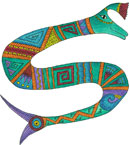| |
|
|
The Caldecott Medal is awarded each year by the American
Library Association to the artist of the most distinguished American Picture
Book for Children published in the United States during the preceding year.
The artist must be a citizen or resident of the United States.
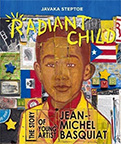 Radiant Child: The Story of Young Artist Jean-Michel Basquiat Radiant Child: The Story of Young Artist Jean-Michel Basquiat
by Javaka Steptoe
Caldecott Medal
2017
Ages 4–8
This beautifully illustrated biography presents the childhood of artist Jean-Michel Basquiat, who learned to see beauty in the messy streets and games of fellow children. His Puerto Rican mother encouraged him by taking him to museums and anatomy textbooks. The illustrations echo Basquiat's vibrant art with layers of paint and paper scraps on found-wood panels. Basquiat's creativity is celebrated in the text, his heroin addiction and early death is mentioned in the afterword. |
|
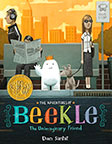 The Adventures of Beekle: The Unimaginary Friend The Adventures of Beekle: The Unimaginary Friend
by Dan Santat
Caldecott Medal
2015
Ages 3–6
Beekle is born on an island of imaginary friends and longs to be imagined by a real child. But though he waits, and waits, and waits, his turn never comes. So Beekle sets out across the water until he reaches the real world where he is eventually spotted by a small girl. They become friends, sharing snacks and jokes and adventures. Beekle’s marshmallow-white body stands out in the rich mixed-media illustrations. |
|
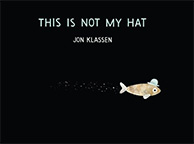 This Is Not My Hat This Is Not My Hat
by Jon Klassen
Caldecott
Medal 2013
Ages 4–8
The small fish narrating this story has snatched a tiny bowler hat from a much larger fish. Though he swears a crab to secrecy as he flees with the hat, the unreliable crab betrays him instantly. This wryly funny book uses both pictures and words to tell the story of the small hat thief determined to keep his stolen prize. |
|
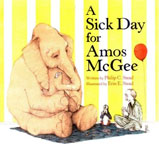 A
Sick Day for Amos McGee A
Sick Day for Amos McGee
by Philip Christian Stead, Erin
Stead
Caldecott
Medal 2011
Ages 2–6
Elderly zookeeper Amos McGee always makes
time in his busy day to spend time with the animals. He plays
chess with the elephant, reads to the owl, and sits quietly with
the penguin. When Amos catches a cold and can’t come to work,
the animals miss him and pile onto the bus to pay him a visit,
each offering a small kindness in return. Erin Stead’s delicate
woodblock prints perfectly complement this gentle story of quiet
affection. |
| |
|
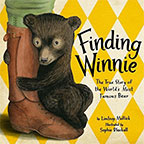 Finding Winnie: The True Story of the World’s Most Famous Bear Finding Winnie: The True Story of the World’s Most Famous Bear
by Lindsay Mattick, Sophie Blackall
Caldecott Medal
2016
Ages 3–6
in 1914, a veterinarian named Harry Colebourn who rescued an orphaned black bear cub while on the way to join his army unit during WWI. He named the bear Winnie, after his home town of Winnipeg, and took her with him to England, where she became the mascot of the Second Canadian Infantry Brigade. Since Winnie couldn’t come with him to France, Harry donated her to the London Zoo where a boy named Christopher Robin discovered her. Lindsay Mattick, the great granddaughter of Captain Colebourn, frames this story as a bedtime tale for her young son Cole. |
|
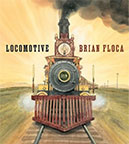 Locomotive Locomotive
by Brian Floca
Caldecott Medal
2014
Ages 4–10
It’s the summer of 1869, and the Transcontinental Railroad has just been completed. A mother and her two children board the train in Omaha, leaving their old home behind to join Papa who has gone ahead to Sacramento, California to prepare their new home. Details about the construction of the railroad and the crew it takes to run the train provide background to the small family enjoying the cross-country journey. |
|
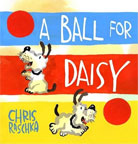 A
Ball for Daisy A
Ball for Daisy
by Chris Raschka
Caldecott Medal
2012
Ages 3–up
This nearly wordless book tells
the story of love and loss. Daisy adores her bright red
ball and is heartbroken when it is accidentally destroyed
while playing with a bigger dog. Daisy’s feelings of
both joy and sadness are brilliantly illustrated in watercolor,
gouache and ink. This simple story of the pain of loss
with a happy ending is sure to appeal to any child who
has mourned the loss of a favorite toy. |
|
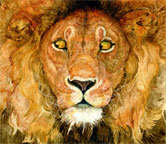 The
Lion & the Mouse The
Lion & the Mouse
by Jerry Pinkney
Caldecott Medal
2010
Ages 3–6
This adaptation of Aesop’s fable is nearly
wordless, but Pinkney’s gorgeous illustrations tell the tale
in stunning detail. |
| |
|
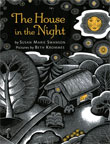 The
House in the Night The
House in the Night
illustrations by Beth
Krommes, text by Susan Marie Swanson
Ages 3–6
Caldecott Medal 2009
Beth Krommes’s magical illustrations
amplify the minimal text to highlight the things
in a house that really matter: books, art, music,
and love. This bedtime book will be treasured by
children and adults alike. |
|
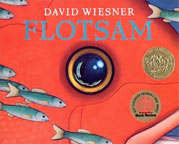 Flotsam Flotsam
by David Wiesner
Caldecott Medal 2007
Ages 4–9
In this wordless picture book, a wave
brings an underwater camera to shore and a boy develops the
film. Amazing photographs emerge: a windup fish, aliens among
the sea horses, an octopus reading, and finally a picture of
a child holding a picture of a child holding a picture of a
child… inviting the reader to discover the narrative
on each page. |
|
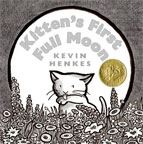 Kitten’s
First Full Moon Kitten’s
First Full Moon
by Kevin Henkes
Caldecott Medal
2005
Ages 3–5
This lively kitten is positive that
the full moon is a bowl of milk and persists in trying to lap
it up despite numerous setbacks. |
|
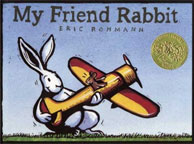 My
Friend Rabbit My
Friend Rabbit
by Eric Rohmann
Caldecott Medal 2003
Ages 4–8
Mouse narrates this story of his friend
Rabbit who has just as much fun getting Mouse out of trouble
as he does getting him into it. Incredible and hilarious illustrations
support the simple story. |
|
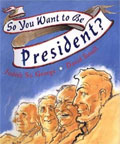 So
You Want to Be President? So
You Want to Be President?
illustrations by David Small,
text by Judith St. George
Caldecott Medal
2001
Ages 8–12
This lighthearted book uses anecdotes
and trivia to convey the message that anyone can be president.
The humorous caricatures highlight each president’s best known
qualities. |
|
 The
Invention of Hugo Cabret The
Invention of Hugo Cabret
by Brian Selznick
Caldecott Medal 2008
Ages 9–12
Hugo, a 12-year-old-orphan lives in
the walls of a Paris train station at the turn of the 20th
century, trying to finish an invention his father left. Black
and white pencil illustrations pay homage to flickering silent
movies. |
|
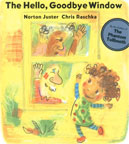 The
Hello, Goodbye Window The
Hello, Goodbye Window
Illustrations by Chris Raschka, text
by Norton Juster
Caldecott Medal 2006
Ages 4–7
A girl visits her grandparents, enjoying
the house and garden and the surprises through the window.
This child-centered view of everyday activities is just right
for reading aloud. The bright illustrations are perfect for
portraying this happy multi-racial family. |
|
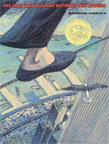 The
Man Who Walked Between the Towers The
Man Who Walked Between the Towers
by Mordicai Gerstein
Caldecott Medal 2004
Ages 5–8
In August 1974, Philippe Petit and
a friend carry a 440-pound reel of cable and other equipment
to the top of the Twin Towers in New York City so that Petit
can walk a tight rope between the towers. Beautifully detailed
paintings illustrate the beauty and danger of this event. |
|
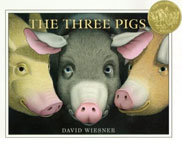 The
Three Pigs The
Three Pigs
by David Wiesner
Caldecott Medal 2002
Ages 5–8
These three clever pigs move from realistic
to storybook illustrations as they manipulate the classic tale.
The use of white space, perspective, and humor make these illustrations
something special. |
|
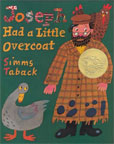 Joseph
Had a Little Overcoat Joseph
Had a Little Overcoat
by Simms Taback
Caldecott Medal 2000
Ages 4–8
When Joseph’s overcoat starts falling
apart he turns it into a jacket, then a vest, then a scaft,
and so on in this adaptation of a Yiddish folksong. The illustrations
are incredibly detailed and full of funny details. |
|
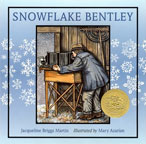 Snowflake
Bentley Snowflake
Bentley
illustrations by Mary Azarian, text
by Jacqueline Briggs Martin
Caldecott Medal 1999
Ages 4–8
This biography of Wilson A. Bentley
tells the story of a rural Vermont farmboy in the mid-19th
century who became fascinated by snowflakes. Bentley developed
a system of microphotography that allowed him to capture images
of snowflakes and prove that no two snowflakes are identical.
Azarian’s woodcuts are perfect. |
|
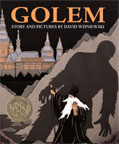 Golem Golem
by David Wisniewski
Caldecott Medal 1997
Ages 6–10
Elaborate cut-paper collage illustrations
provide dramatic visuals for this retelling of the Jewish legend
of Rabbi Loew who used his powers to create a gigantic Golem
from clay to protect his people from persecution in the ghettos
of 16th-century Prague. |
|
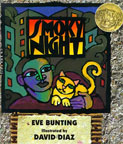 Smoky
Night Smoky
Night
illustrations by David Diaz, text by
Eve Bunting
Caldecott Medal 1995
Ages 5–10
Daniel’s cat doesn’t get along with
Mrs. Kim’s cat and Daniel’s mother doesn’t shop at Mrs. Kim’s
store, preferring to patronize African-American stores. But
when Daniel’s apartment building goes up in flames, all the
neighbors, including the cats, learn the importance of working
together and accepting differences. Inspired by the Los Angeles
riots, this book delivers a message about racism with a light
touch supported by dazzling mixed-media collage illustrations. |
|
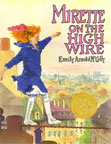 Mirette
on the High Wire Mirette
on the High Wire
by Emily Arnold McCully
Caldecott Medal 1993
Ages 4–8
Mirette helps “The Great Bellini” regain
his confidence while he stays at her mother’s boarding house
and eventually the two are walking the high wire above the
rooftops of the city. Rich illustrations capture 19th-century
Paris. |
|
 Black
and White Black
and White
by David Macaulay
Caldecott Medal 1991
Ages 4–10
Four stories, that at first seem unrelated,
each occupy a fourth of each two-page spread. The interactions
between the four stories creates a fifth. There is no resolution,
challenging readers to discover new meaning with each reading. |
|
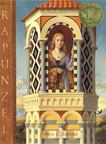 Rapunzel Rapunzel
by Paul O. Zelinsky
Caldecott Medal 1998
Ages 4–10
The beautiful Italian Renaissance-styled
illustrations with warm golden tones bring the classic Brothers
Grimm fairy tale to life. |
|
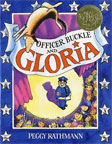 Officer
Buckle and Gloria Officer
Buckle and Gloria
by Peggy Rathmann
Caldecott Medal 1996
Ages 4–8
Officer Buckle’s school safety assemblies
are so boring that his audience falls asleep. Then police dog
Gloria joins the act and pantomimes each safety tip behind
the unsuspecting Officer Buckle who is amazed that his audience
suddenly finds him funny. The hilarious illustrations make
this book something special. |
|
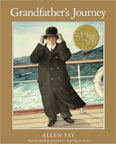 Grandfather’s
Journey Grandfather’s
Journey
by Allen Say
Caldecott Medal
1994
Ages 4–8
This book tells the story of Say’s
grandfather who sailed from Japan to North America, ending
up in California. He returned to Japan to marry his sweetheart,
bringing her back to California. When his daughter is nearly
grown, he takes his family back to Japan. In Japan they miss
California and return to America. The beautiful illustrations
perfectly capture the feeling of always being homesick for
one country or the other. |
|
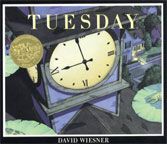 Tuesday Tuesday
by David Wiesner
Caldecott Medal 1992
Ages 5–8
In this nearly wordless book, the frogs
on their lily pads soar through the night. The illustrations
perfectly capture the surreal magic of flying frogs. |
|
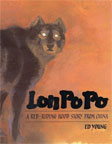 Lon
Po Po: Lon
Po Po:
A
Red-Riding Hood Story from China
by Ed Young
Caldecott Medal 1990
Ages 4–8
Three daughters left at home while
their mother goes to visit Grandmother are almost fooled by
Lon Po Po, the wolf pretending to be their Grandmother. Incredible
illustrations that are both realistic and abstract add to the
power of this retelling of the classic tale. |
|
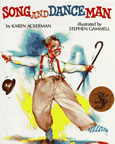 Song
and Dance Man Song
and Dance Man
by Karen Ackerman
Caldecott Medal 1989
Ages 3–7
One afternoon a visit to the attic
convinces Grandpa to recreate his vaudeville song and dance
act for his three delighted grandchildren. The colorful illustrations
capture the children’s viewpoint of this delightful event. |
|
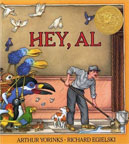 Hey,
Al Hey,
Al
illustrations by Richard Egielski, text
by Arthur Yorinks
Caldecott Medal 1987
Ages 4–8
A strange bird offers to take Al, the
janitor, and his dog Eddie to a wonderful place with no worries.
The strange and beautiful place is indeed paradise, but Al
and Eddie eventually decide that home is better. |
|
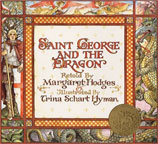 Saint
George and the Dragon Saint
George and the Dragon
illustrations by Trina Schart Hyman,
text by Margaret Hodges
Caldecott Medal 1985
Ages 4–8
George, the Red Cross Knight, slays
the dreadful dragon that has been terrorizing the countryside
for years and brings peace and joy to the land. The illustrations
for the retelling of this segment from Spenser’s The Faerie
Queene are rich in detail and sparkle with gold highlights. |
|
 Shadow Shadow
by Marcia Brown
Caldecott Medal 1983
Ages 5–8
Marcia Brown's stunning African-inspired
collage illustrations evoke the atmosphere and drama of a life
now haunted, now enchanted by Shadow. (translated by Marcia
Brown from the French poetry of Blaise Cendrars) |
|
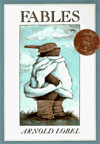 Fables Fables
by Arnold Lobel
Caldecott Medal 1981
Ages 6–10
These short original fables have unexpected
morals. The humorous illustrations add to the fun. |
|
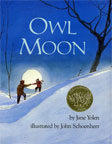 Owl
Moon Owl
Moon
illustrations by John Schoenherr, text
by Jane Yolen
Caldecott Medal 1988
Ages 3–8
A young girl and her father go owling
late one winter night. The lyrical text and beautiful illustrations
combine to transform this simple event into a magical adventure. |
|
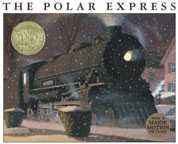 The
Polar Express The
Polar Express
by Chris Van Allsburg
Caldecott Medal 1986
Ages 6–8
The Polar Express is an old-fashioned
steam train that takes children to the North Pole on Christmas
Eve. Incredible illustrations evoke a memory of a long-ago
time. |
|
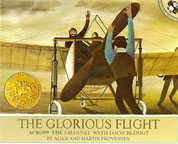 The
Glorious Flight: The
Glorious Flight:
Across
the Channel with Louis Blériot
by Alice & Martin Provensen
Caldecott Medal 1984
Ages 4–8
This book shows the persistence of
Louis Blériot, a Frenchman, who was determined to to
build a flying machine to cross the English Channel. His glorious
flight occurred on July 25, 1909. |
|
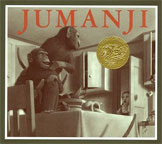 Jumanji Jumanji
by Chris Van Allsburg
Caldecott Medal 1982
Ages 8–12
When Judy and Peter find a board game
in the park, they take it home and begin to play. Soon the
jungle adventure comes to life and chimps and rhinos are roaming
through the house. Incredibly detailed illustrations bring
the perilous predicaments to life. |
|
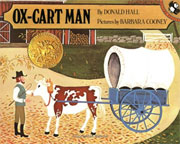 Ox-Cart
Man Ox-Cart
Man
illustrations by Barbara Cooney, text
by Donald Hall
Caldecott Medal 1980
Ages 4–8
The stunning combination of text and
illustrations recreates the mood of 19-century rural New England. |
|
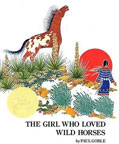 The
Girl Who Loved Wild Horses The
Girl Who Loved Wild Horses
by Paul Goble
Caldecott Medal 1979
Ages 5–8
The girl in this Native American tale
loves horses so much that eventually she leaves her people
to live with the herd. The bold illustrations beautifully complement
this story of a girl who followed her heart with the support
of her village. |
|
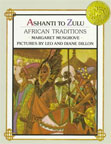 Ashanti
to Zulu: Ashanti
to Zulu:
African
Traditions
illustrations by Leo & Diane Dillon,
text by Margaret Musgrove
Caldecott Medal 1977
Ages 6–12
Incredible pictures illustrate the
traditions and customs of 26 African tribes beginning with
letters from A to Z. Most paintings include a man, woman, child,
artifact, living quarters, and a local animal. |
|
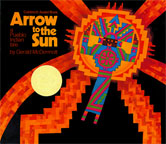 Arrow
to the Sun: Arrow
to the Sun:
A
Pueblo Indian Tale
by Gerald McDermott
Caldecott Medal 1975
Ages 4–8
A young boy searches for his father
and must prove he is worthy by passing through four ceremonial
chambers in this retelling of the Pueblo Native American legend.
The bold and colorful geometric illustrations echo Pueblo designs. |
|
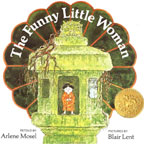 The
Funny Little Woman The
Funny Little Woman
illustrations by Blair Lent, text
by Arlene Mosel
Caldecott Medal
1973
Ages 3–8
Long ago in old Japan a funny little
woman with a silly little laugh chases a runaway dumpling and
soon finds herself cooking dumplings for a band of demons.
Her infectious laugh helps her charm the demons into releasing
her. |
|
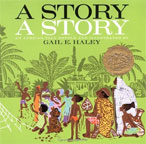 A
Story, A Story A
Story, A Story
by Gail E. Haley
Caldecott Medal 1971
Ages 4–8
In the beginning there were no stories
for children to hear, so Ananse the Spider went to bargain
with Nyame, the Sky God, to bring the stories down to Earth.
Wonderful woodcut illustrations support the clever text in
this retelling of an African folktale. |
|
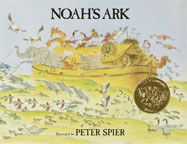 Noah’s
Ark Noah’s
Ark
by Peter Spier
Caldecott Medal
1978
Ages 2–6
Minimal text and detailed illustrations
retell the Biblical story of Noah and the paired animals on
his ark. |
|
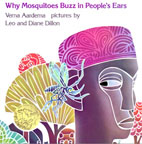 Why
Mosquitoes Buzz in People’s Ears Why
Mosquitoes Buzz in People’s Ears
illustrations by Leo & Diane Dillon,
text by Verna Aardema
Caldecott Medal 1976
Ages 5–8
This retelling of a traditional West
African tale reveals how the mosquito developed its annoying
habit of buzzing in people’s ears. The wax-resist style illustrations
are incredible. |
|
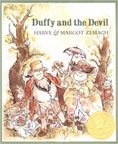 Duffy
and the Devil Duffy
and the Devil
ilustrations by Margot Zemach, text
by Harve Zemach
Caldecott Medal 1974
Ages 4–8
This comic version of the Rumpelstiltskin
story is based on a 19th century play from Cornwall, England.
The pen and wash illustrations are rich in detail and humorous
interpretation of the characters. |
|
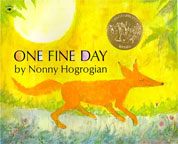 One
Fine Day One
Fine Day
by Nonny Hogrogian
Caldecott Medal
1972
Ages 4–8
In this humorous retelling of an Armenian
folktale, a fox steals some milk from an old farm woman. She
cuts off his tail, and the fox spends the rest of the day bargaining
to get it back. The vividly beautiful illustrations bring this
tale to life. |
|
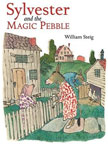 Sylvester
and the Magic Pebble Sylvester
and the Magic Pebble
by William Steig
Caldecott Medal 1970
Ages 4–8
Sylvester the donkey finds a magic
pebble that will grant his every wish. Unfortunately Sylvester
is startled by a lion and wishes he were a rock and then cannot
hold the magic pebble to wish himself back to normal again.
The glorious watercolor illustrations convey the nuances of
this touching story. |
|
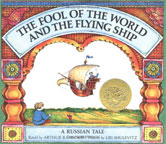 The
Fool of the World and the Flying Ship The
Fool of the World and the Flying Ship
illustrations by Uri Shulevitz, text
by Arthur Ransome
Caldecott Medal 1969
Ages 4–8
In this retelling of a Russian folktale,
the simple third son is helped by those with magical powers
to perform the impossible tasks set by the Czar and wins the
princess. The colorful illustrations have a wonderful Russian
folk-art look. |
|
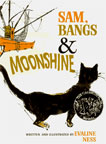 Sam,
Bangs & Moonshine Sam,
Bangs & Moonshine
by Evaline Ness
Caldecott Medal
1967
Ages 4–8
Samantha is a fisherman’s daughter
who lives in her imagination. Everyone calls her fantasies
moonshine. One day she sends her friend Thomas and her cat
Bangs out to sea to look for her escaped pet kangaroo. A sudden
storm makes Sam rethink the line between moonshine and reality. |
|
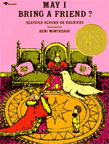 May
I Bring a Friend? May
I Bring a Friend?
illustrations by Beni Montresor, text
by Beatrice Schenk de Regniers
Caldecott Medal 1965
Ages 3–8
The King and Queen are always gracious,
even when their guest brings along a wild animal or several.
The richly colored illustrations show the well-behaved animals
causing unintentional havoc in the palace. |
|
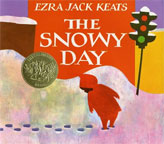 The
Snowy Day The
Snowy Day
by Ezra Jack Keats
Caldecott Medal 1963
Ages 4–8
A small boy wakes up to discover that
snow has fallen overnight. The beautiful illustrations of watercolor
and collage show the magic of simple experiences in the snow. |
|
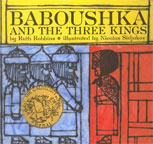 Baboushka
and the Three Kings Baboushka
and the Three Kings
illustrations by Nicolas Sidjakov,
text by Ruth Robbins
Caldecott Medal 1961
Ages 4–8
The Three Kings coming from the East
to bring gifts to a new-born child lose their way in the snow
in Russia and knock on Baboushka’s door. She is too busy with
her chores to join them. The next morning she is sorry she
refused and tries to follow with her own gifts but the trail
is covered by new snow. Baboushka gives her gifts to other
children instead. The strong primary colors and bold outlines
emphasize the Russian theme of the story. |
|
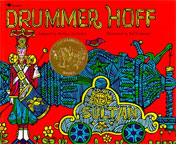 Drummer
Hoff Drummer
Hoff
illustrations by Ed Emberley, text by
Barbara Emberley
Caldecott Medal 1968
Ages 3–8
Seven soldiers build an incredible
cannon which Drummer Hoff sets off. The cumulative rhymes and
repetition in the text encourage young children to “read
along” while admiring the brightly-colored woodcut illustrations. |
|
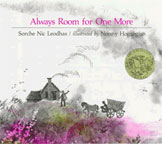 Always
Room for One More Always
Room for One More
illustrations by Nonny Hogrogian, text
by Sorche Nic Leodhas
Caldecott Medal 1966
Ages 4–8
Travelers in a storm are glad to hear
Lachie MacLachlan generously call out that there is always
room for one more. Narrated in a lilting, rhyming brogue, the
Scottish travelers fill the little house until it explodes. |
|
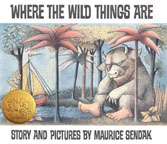 Where
the Wild Things Are Where
the Wild Things Are
by Maurice Sendak
Caldecott Medal 1964
Ages 4–8
Max puts on his wolf suit and gets
sent to bed without supper. Luckily a forest grows in his room
and he can rampage with the other wild things. The hilarious
wild things, scary-looking without actually being scary, and
the wonderful run-on sentences of the simple text combine to
create an incredible view inside a child’s imagination. |
|
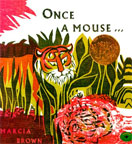 Once
a Mouse… Once
a Mouse…
by Marcia Brown
Caldecott Medal
1962
Ages 4–8
The mighty tiger challenges anyone
to say he was once a mouse, but the hermit knows it to be true,
since he himself used magic to transform the mouse into a cat
and then a dog and finally a tiger. And unfortunately for the
too proud tiger, those changes can be reversed. Beautiful woodcuts
illustrate this Indian fable. |
|
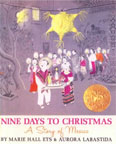 Nine
Days to Christmas Nine
Days to Christmas
by Marie Hall Ets
Caldecott Medal 1960
Ages 4–8
Ceci is five years old and her mother
has finally agreed to host a posada (Christmas festival in
Mexico). Ceci is allowed to choose the piñata and becomes
too attached to the glorious star she picks. Detailed pencil
drawings highlight Ceci’s joy and her beautiful Mexican town. |
|
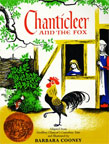 Chanticleer
and the Fox Chanticleer
and the Fox
by Barbara Cooney
Caldecott Medal 1959
Ages 4–8
Chanticleer the rooster falls for the
flattery of the fox and is caught. Luckily Chanticleer is clever
enough to think himself out of danger in this retelling of
the
“Nun’s Priest’s Tale” from Geoffrey Chaucer’s Canterbury
Tales. Beautiful pen and ink drawings illustrate the
fable. |
|
 A
Tree Is Nice A
Tree Is Nice
illustrations by Marc Simont, text by
Janice Udry
Caldecott Medal 1957
Ages 4–8
This book explores all the benefits
that trees bring us in simple text suitable for young readers.
The elongated shape of the book allows the beautiful illustrations
to capture the graceful height of trees. |
|
 Cinderella,
or the Little Glass Slipper Cinderella,
or the Little Glass Slipper
by Marcia Brown
Caldecott Medal
1955
Ages 4–8
This retelling of the classic tale
by Charles Perrault is a skillful version that is both simple
and romantic. The pen and watercolor illustrations complement
the story beautifully. |
|
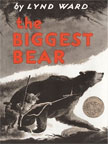 The
Biggest Bear The
Biggest Bear
by Lynd Ward
Caldecott Medal 1953
Ages 4–8
Johnny sets off to kill the biggest
bear he can find, but since all he finds is a cup he brings
it home. When the bear grows too big to keep as a pet, Johnny
tries to set it free, but the bear keeps returning at supper
time. Finally Johnny has to find permanent solution. Beautifully
detailed illustrations capture rural life perfectly. |
|
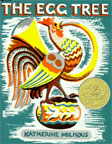 The
Egg Tree The
Egg Tree
by Katherine Milhous
Caldecott Medal 1951
Ages 5–8
Katy discovers her grandmother’s old
hand-painted eggs while on a family Easter egg hunt. Grandmom
had painted the eggs when she was a little girl, and shows
Katy how to hang them on the special egg tree. The beautiful
Pennsylvania-Dutch inspired illustrations will inspire readers
to paint eggs of their own. |
|
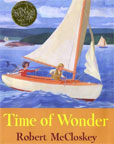 Time
of Wonder Time
of Wonder
by Robert McCloskey
Caldecott Medal 1958
Ages 4–8
Two sisters spend a glorious summer
in Maine on Penobscot Bay, swimming, sailing, and experiencing
a storm. The poetic language and beautiful illustrations capture
this magical time. |
|
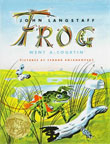 Frog
Went A-Courtin’ Frog
Went A-Courtin’
illustrations by Feodor Rojankovsky,
text by John Langstaff
Caldecott Medal 1956
Ages 4–8
In this version of the old song, Froggy
puts on his shiny black boots and goes out to court Miss Mousy.
The colorful illustrations bring this book to life. Included
are the words and music to the song. |
|
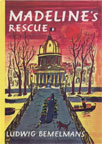 Madeline’s
Rescue Madeline’s
Rescue
by Ludwig Bemelmans
Caldecott Medal
1954
Ages 4–8
One day on a walk through Paris Madeline
slips and falls off a bridge right into the Seine and is rescued
by a brave dog. The girls take the dog home, but she is banned
from the house, so the girls must search all of Paris to find
her again. Incredible illustrations complement the rhyming
text. (sequel to Madeline) |
|
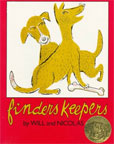 Finders
Keepers Finders
Keepers
illustrations by Nicolas Mordvinoff,
text by William Lipkind
Caldecott Medal 1952
Ages 4–8
Nap and Winkle dig up a bone together
in the yard and can’t decide who it belongs to since Nap saw
it first and Winkle touched it first. People passing by can’t
help them solve their disagreement until another dogs offers
a solution both can agree to. The humorous illustrations fit
the story perfectly. |
|
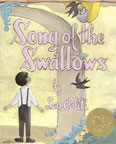 The
Song of the Swallows The
Song of the Swallows
by Leo Politi
Caldecott Medal 1950
Ages 4–8
Julian, the gardener and bell-ringer
at Mission San Juan Capistrano, shares his love of the swallows
that return every year with his young friend Juan. This year
Juan plants his own garden and hopes that the swallows will
build a nest there. Beautiful watercolor illustrations capture
the magic of the migrating birds. |
|
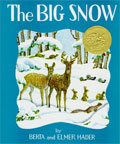 The
Big Snow The
Big Snow
by Berta & Elmer Hader
Caldecott Medal 1949
Ages 4–8
Simple text and beautiful illustrations
tell the story of how the woodland creatures prepare for winter.
In the winter of the big snow, the people who live in the little
stone house help the animals by putting food out for them. |
|
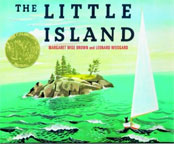 The
Little Island The
Little Island
illustrations by Leonard Weisgard, text
by Margaret Wise Brown
Caldecott Medal 1947
Ages 4–9
The little island is rich with plant
and animal life despite its remote location. The illustrations
beautifully document the seasonal changes. |
|
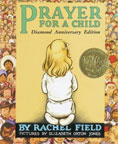 Prayer
for a Child Prayer
for a Child
illustrations by Elizabeth Orton Jones,
text by Rachel Field
Caldecott Medal 1945
Ages 2–5
The sweet, simple illustrations are
a perfect match for this version of prayer from a child’s viewpoint. |
|
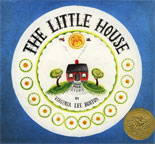 The
Little House The
Little House
by Virginia Lee Burton
Caldecott Medal 1943
Ages 3–6
The little house in the country was
happy until the city grew large enough to surround her. Finally
a woman rescues the house by moving it back to the country.
The whimsical drawings are delightful. |
|
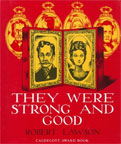 They
Were Strong and Good They
Were Strong and Good
by Robert Lawson
Caldecott Medal 1941
Ages 9–12
Lawson shares the story of three generations
of his family, none of whom were great or famous. Humorous
and detailed illustrations highlight the human aspect of this
history. The views of other races and cultures are accurate
for the time, but will need interpretation for modern readers. |
|
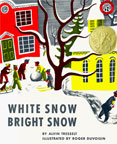 White
Snow, Bright Snow White
Snow, Bright Snow
illustrations by Roger Duvoisin, text
by Alvin Tresselt
Caldecott Medal 1948
Ages 4–8
When the snow begins to fall, the adults
rush around doing important chores, but the children dance
and try to catch snowflakes on their tongues. The bright illustrations
capture a child’s delight in the first snow of the season. |
|
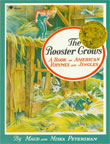 The
Rooster Crows: The
Rooster Crows:
A
Book of American Rhymes and Jingles
by Maud & Miska Petersham
Caldecott Medal 1946
Ages 3–8
This book is full of nursery rhymes,
counting-out games, skipping-rope songs, finger games, and
other jingles. |
|
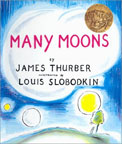 Many
Moons Many
Moons
illustrations by Louis Slobodkin, text
by James Thurber
Caldecott Medal 1944
Ages 4–8
Once there was a little princess who
wanted the moon, but no one could get it for her—not
her father, the king, his wise men, or the jester. Finally
the little princess solves the problem herself. The beautiful
watercolors portray the magical quality of this tale. |
|
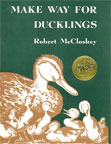 Make
Way for Ducklings Make
Way for Ducklings
by Robert McCloskey
Caldecott Medal 1942
Ages 3–8
Mr. and Mrs. Mallard are having trouble
finding the perfect nest site until they reach Boston’s Public
Garden. Safe from foxes and turtles, and plenty of peanuts,
this must be the perfect spot. The lovely humorous illustrations
beautifully support the gentle minimal text. |
|
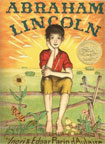 Abraham
Lincoln Abraham
Lincoln
by Ingri & Edgar Parin d’Aulaire
Caldecott Medal 1940
Ages 8–12
Idealized view of the young Abraham
Lincoln supported by charming illustrations. |
|
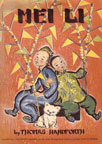 Mei
Li Mei
Li
by Thomas Handforth
Caldecott Medal 1939
Ages 4–8
Mei Li convinces her older brother
to take her to the New Year Fair in the city where they enjoy
all kinds of exciting events. |
|
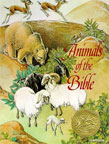 Animals
of the Bible Animals
of the Bible
by Dorothy P. Lathrop
Caldecott Medal 1938
Ages 6–10
Richly detailed drawings illustrate
verses from the King James Bible. |
|
|
